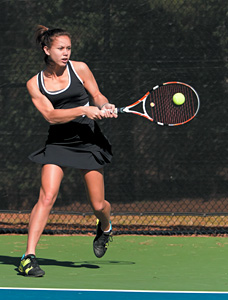Abstract / Introduction
A retrospective, single case study of an adolescent athlete with lateral elbow pain is presented below. The approach to care is customer-centric; in this case, cultural- and sport-specific service-based.
In sports injury care, our assistance should be focused and our energies directed toward a systematic approach. Moreover, there are special areas of concern in caring for the adolescent athlete, as exemplified below.
Case History / Observations
The patient is a 14-year-old female athlete of Japanese-American decent seeking a future collegiate tennis scholarship. She presents with elbow and arm pain of four months' duration. She experienced a similar problem about two years ago. The male parent is of first-generation Japanese descent and refused medical intervention or any prescription medication management for his daughter. His health care medical provider is also of Japanese descent and generated this medical referral. The patient is a full-time student with daily sports activities that include anywhere from 3-6 hours of training per day.
 Many sports require controlled use of the hands; thus, the ability to orient the hand in space is vital. This ability, whether pitching or rolling a ball, depends on the painless function of elbow joint motion. A systemic approach coupled with a working knowledge of the anatomy is an essential component to a patient-centered approach.
Many sports require controlled use of the hands; thus, the ability to orient the hand in space is vital. This ability, whether pitching or rolling a ball, depends on the painless function of elbow joint motion. A systemic approach coupled with a working knowledge of the anatomy is an essential component to a patient-centered approach.
This article does not address the anatomy and biomechanics of the elbow; I recommend the clinician review this topic. In addition, in dealing with an adolescent athlete, pay particular attention to the typical open growth patterns specific to the involved injured joint. For example, in this patient's age group, there are six major secondary centers of ossification that exist in the elbow, which appear and unite with the epiphysis at characteristic ages: capitellum fuses at 14 years, radial head fuses at 16 years, medial epicondyle fuses at 15 years, trochlea fuses at 14 years, olecranon fuses at 14 years and lateral epicondyle fuses at 16 years.
It has been demonstrated that the blood supply to the capitulum is limited past age 10 years in adolescents. Disturbance of the circulation superimposed by overuse is believed to give rise to Panner's disease (capitellar osteochondrosis) in the younger athlete – an ischemic necrosis.4
Examination and Diagnosis
Examination usually begins with palpation to precisely localize the injured structures. Range-of-motion testing is performed in active and passive ranges, and includes joint-play examination. Neurologic and orthopedic evaluation of the elbow and forearm should also be performed. Lateral elbow pain or paraesthesias produced by resisted extension of the middle finger with the elbow extended (i.e., Maudsley's test) is indicative of radial tunnel syndrome.
A primary injury diagnosis for this athlete included lateral epicondylitis (ICD-9 coding 726.32). This is a commonly experienced elbow injury, although today, more women tennis players are using the two-handed backhand, which reduces stress at the lateral elbow, hence minimizing the occurrence of overuse lateral epicondylitis.1
If diagnostic imaging is utilized, keep in mind that for patients younger than age 16, incomplete supracondylar fractures are difficult to diagnose. These and osteochondral fractures are best evaluated by computed tomography scan or magnetic resonance imaging. A pediatric sports orthopedist can help you decide which of these two modalities should be pursued.
Discussion Including Tips on Conservative Management
To excel in sports today, the young athlete is forced to train longer, harder and much earlier in life. The price they pay is overuse syndromes, or the gradual wear and tear of specific parts of the body that eventually lead to an overuse injury. Typical injury classifications seen in the elbow are sprains, strains, contusions, lacerations, fractures and inflammatory reactions.1
It is important to remember that the elbow muscles are most used when the tennis ball impacts the racquet, often at a very high velocity and with significant force imposed on the elbow joint. Thus, this athlete's injury was approached as an overuse syndrome. A predisposition for joint hypermobility may be genetic or gender-related. As a result of loose shoulders, female athletes may be more prone to overuse syndromes and microtrauma, with an increased risk of converting global laxity to symptomatic instability.2 Activities that place extreme loads on the elbow joint, such as gymnastics and tennis, have been implicated in overuse injuries at the elbow joint.
As overall participation by women in sports continues to grow, interest in gender-related injury patterns has also grown.4 It is postulated that women have less upper-body strength than men due to a lower proportion of lean tissue; hence, musculotendinous support of the elbow may be less in women as compared to men. However, presently categories of reported musculoskeletal injuries are grouped by the sport in which they are incurred, not specifically by gender.5
In this case, the athlete was provided education on "balancing" and proper strengthening of the forearm extensor muscles, advice on a regular warm-up routine, and paying attention to technical components such as grip size and proper technique. Management included chiropractic sports rehabilitation training with manipulation of the extremity joints.
According to a Netherlands orthopedic center pilot study that compared treatment protocols (extremity manipulation versus physical therapy modalities such as ultrasound and friction massage), manipulation of the wrist appeared to be more effective than ultrasound, friction massage, and muscle stretching and strengthening exercises for the management of lateral epicondylitis.3
Chiropractic management also included emphasizing the importance of adequate rest and inclusion of peer socialization activities of a noncompetitive nature. The athlete needed to be "mentally ready" to return to their sport. The astute practitioner recognizes this in the management and return-to-play criteria for our young athletes.
To that end, I had a discussion with the male parent about providing his daughter with additional physical training such as Aikido (Japanese: "way of spiritual harmony"), a self-defense system that utilizes twisting and throwing techniques. Recognition and respect for cultural influences can be an important influence on your relationship with today's athlete and their families.
Aikido emphasizes the importance of achieving complete mental calm and control of one's own body to master an opponent's attack. I have been involved with this form of exercise for over 20 years, and find it particularly helpful for young women to master, as it assists their self-growth. It has been suggested that the positive effects of exercise on women's self-esteem does not always have to come from competitive athletics.6
References
- Andrews, et al. Elbow Injuries. In: Native A (editor): The Female Athlete. Philadelphia: Saunders, 2002:479-488.
- Beasley L, Faryniarz DA, Hannafin JA. Multidirectional instability of the shoulder in the female athlete. Clin Sports Med, 2000;19(2):331-349.
- Struijs PAA, Damen P-J, Bakker EWP, et al. Manipulation of the wrist for management of lateral epicondylitis: a randomized pilot study. Phys Ther, 2003 Jul;(7):608-16.
- Hyde TE. Conservative Management of Sports Injuries. The Female Athlete. Jones and Bartlett, 2007:867-885.
- Wiggins DL, Wiggins ME. The female athlete. Clin Sports Med, 1997;16:593-612.
- Barnett NP, Wright P. Psychological considerations for women in sports. Clin Sports Med, 1994;13(2):297-313.
Click here for previous articles by Nancy Martin-Molina, DC, QME, MBA, CCSP.





